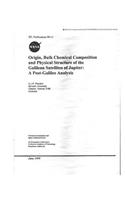
Origin, Bulk Chemical Composition and Physical Structure of the Galilean Satellites of Jupiter
Series:
The origin of Jupiter and the Galilean satellite system is examined in the light of the new data that has been obtained by the NASA Galileo Project. In particular, special attention is given to a theory of satellite origin which was put forward at the start of the Galileo Mission and on the basis of which several predictions have now been proven successful. These predictions concern the chemical c
NaN
VOLUME
English
Paperback

The origin of Jupiter and the Galilean satellite system is examined in the light of the new data that has been obtained by the NASA Galileo Project. In particular, special attention is given to a theory of satellite origin which was put forward at the start of the Galileo Mission and on the basis of which several predictions have now been proven successful. These predictions concern the chemical composition of Jupiter's atmosphere and the physical structure of the satellites. According to the proposed theory of satellite origin, each of the Galilean satellites formed by chemical condensation and gravitational accumulation of solid grains within a concentric family of orbiting gas rings. These rings were cast off equatorially by the rotating proto-Jovian cloud (PJC which contracted gravitationally to form Jupiter some 4 1/2 billion years ago. The PJC formed from the gas and grains left over from the gas ring that had been shed at Jupiter's orbit by the contracting proto-solar cloud (PSC Supersonic turbulent convection provides the means for shedding discrete gas rings. The temperatures T (sub n) of the system of gas rings shed by the PSC and PJC vary with their respective mean orbital radii R (sub n) (n = 0, 1,2, ...) according as T (sub n) proportional to R (sub n) (exp -0.9). If the planet Mercury condenses at 1640 K, so accounting for the high density of that planet via a process of chemical fractionation between iron and silicates, then T (sub n) at Jupiter's orbit is 158 K. Only 35% of the water vapour condenses out. Thus fractionation between rock and ice, together with an enhancement in the abundance of solids relative to gas which takes place through gravitational sedimentation of solids onto the mean orbit of the gas ring, ensures nearly equal proportions of rock and ice in each of Ganymede and Callisto. Io and Europa condense above the H20 ice point and consist solely of hydrated rock (h-rock). The Ganymedan condensate consists of h-rock and H20 ice. For Ca
Price Comparison [India]
In This Series
Bestseller Manga
Trending NEWS




















